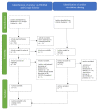Teledentistry Implementation During the COVID-19 Pandemic: Scoping Review
- PMID: 35862174
- PMCID: PMC9307266
- DOI: 10.2196/39955
Teledentistry Implementation During the COVID-19 Pandemic: Scoping Review
Abstract
Background: COVID-19 spreads via aerosol droplets. The dental profession is at high risk of contracting the virus since their work includes treatment procedures that produce aerosols. Teledentistry offers an opportunity to mitigate the risk to dental personnel by allowing dentists to provide care without direct patient contact.
Objective: The purpose of this scoping review was to examine the implementation, challenges, strategies, and innovations related to teledentistry during the COVID-19 pandemic lockdown.
Methods: This scoping review evaluated teledentistry use during the pandemic by searching for articles in PubMed and Google Scholar using the search terms teledentistry, tele-dentistry, covid-19, coronavirus, telehealth, telemedicine, and dentistry. Inclusion criteria consisted of articles published in English from March 1, 2020, to April 1, 2022, that were relevant to dentistry and its specialties, and that included some discussion of teledentistry and COVID-19. Specifically, the review sought to explore teledentistry implementation, challenges, strategies to overcome challenges, and innovative ideas that emerged during the pandemic. It followed the 2020 Preferred Reporting Items for Systematic reviews and Meta-Analyses for Scoping Reviews (PRISMA-ScR). This approach is organized into 5 distinct steps: formulating a defined question, using the question to develop inclusion criteria to identify relevant studies, an approach to appraise the studies, summarizing the evidence using an explicit methodology, and interpreting the findings of the review.
Results: A total of 32 articles was included in this scoping review and summarized by article type, methodology and population, and key points about the aims; 9 articles were narrative review articles, 10 were opinion pieces, 4 were descriptive studies, 3 were surveys, 2 were integrative literature reviews, and there was 1 each of the following: observational study, systematic review, case report, and practice brief. Teledentistry was used both synchronously and asynchronously for virtual consultations, often employing commercial applications such as WhatsApp, Skype, and Zoom. Dental professionals most commonly used teledentistry for triage, to reduce in-person visits, and for scheduling and providing consultations remotely. Identified challenges included patient and clinician acceptance of teledentistry, having adequate infrastructure, reimbursement, and security concerns. Strategies to address these concerns included clinician and patient training and utilizing Health Insurance Portability and Accountability Act-compliant applications. Benefits from teledentistry included providing care for patients during the pandemic and extending care to areas lacking access to dental care.
Conclusions: Pandemic lockdowns led to new teledentistry implementations, most commonly for triage but also for follow-up and nonprocedural care. Teledentistry reduced in-person visits and improved access to remote areas. Challenges such as technology infrastructure, provider skill level, billing issues, and privacy concerns remain.
Keywords: COVID-19; dental profession; implementation; innovation; pandemic; teledentistry; telehealth.
©Man Hung, Martin S Lipsky, Teerarat N Phuatrakoon, Mindy Nguyen, Frank W Licari, Elizabeth J Unni. Originally published in the Interactive Journal of Medical Research (https://www.i-jmr.org/), 21.07.2022.
Conflict of interest statement
Conflicts of Interest: None declared.
Figures
Similar articles
-
Beyond the black stump: rapid reviews of health research issues affecting regional, rural and remote Australia.Med J Aust. 2020 Dec;213 Suppl 11:S3-S32.e1. doi: 10.5694/mja2.50881. Med J Aust. 2020. PMID: 33314144
-
Barriers and Enablers to Implementing Teledentistry From the Perspective of Dental Health Care Professionals: Protocol for a Systematic Quantitative, Qualitative, and Mixed Studies Review.JMIR Res Protoc. 2023 Jul 26;12:e44218. doi: 10.2196/44218. JMIR Res Protoc. 2023. PMID: 37494093 Free PMC article.
-
Teledentistry during COVID-19 pandemic.Diabetes Metab Syndr. 2020 Sep-Oct;14(5):933-935. doi: 10.1016/j.dsx.2020.06.029. Epub 2020 Jun 16. Diabetes Metab Syndr. 2020. PMID: 32593116 Free PMC article. Review.
-
The Use of Telehealth Among People Living With Dementia-Caregiver Dyads During the COVID-19 Pandemic: Scoping Review.J Med Internet Res. 2023 May 25;25:e45045. doi: 10.2196/45045. J Med Internet Res. 2023. PMID: 37227755 Free PMC article.
-
INTEGRATION OF DENTAL PATIENT-REPORTED OUTCOMES (dPROs) IN TELEDENTISTRY TO ENHANCE PATIENT-CENTERED CARE: A SCOPING REVIEW.J Evid Based Dent Pract. 2025 Mar;25(1):102084. doi: 10.1016/j.jebdp.2024.102084. Epub 2024 Dec 30. J Evid Based Dent Pract. 2025. PMID: 39947782
Cited by
-
A Tele-detection and referral pAthways model for early childhood cariEs control- a protocol for a randomized factorial study: the TRACE study.BMC Oral Health. 2024 Aug 11;24(1):934. doi: 10.1186/s12903-024-04706-8. BMC Oral Health. 2024. PMID: 39129017 Free PMC article.
-
Teledentistry Applied to Health and Education Outcomes: Evidence Gap Map.J Med Internet Res. 2024 Nov 27;26:e60590. doi: 10.2196/60590. J Med Internet Res. 2024. PMID: 39602783 Free PMC article. Review.
-
Teleconsultations in oral medicine: dentist perception during the COVID-19 pandemic in Brazil.Med Oral Patol Oral Cir Bucal. 2024 Jul 1;29(4):e492-e497. doi: 10.4317/medoral.26456. Med Oral Patol Oral Cir Bucal. 2024. PMID: 38615250 Free PMC article.
-
Teledentistry-Dental students' preparedness and patients' experiences.PLoS One. 2025 Feb 13;20(2):e0318991. doi: 10.1371/journal.pone.0318991. eCollection 2025. PLoS One. 2025. PMID: 39946493 Free PMC article.
-
Teledentistry from research to practice: a tale of nineteen countries.Front Oral Health. 2023 Jun 16;4:1188557. doi: 10.3389/froh.2023.1188557. eCollection 2023. Front Oral Health. 2023. PMID: 37397348 Free PMC article. Review.
References
-
- Umakanthan S, Sahu P, Ranade A, Bukelo M, Rao J, Abrahao-Machado L, Dahal S, Kumar H, Kv D. Origin, transmission, diagnosis and management of coronavirus disease 2019 (COVID-19) Postgrad Med J. 2020 Dec;96(1142):753–758. doi: 10.1136/postgradmedj-2020-138234.postgradmedj-2020-138234 - DOI - PMC - PubMed
-
- Guidance for Institutions of Higher Education (IHEs) Centers for Disease Control and Prevention. [2022-07-14]. https://www.cdc.gov/coronavirus/2019-ncov/community/colleges-universitie... .
Publication types
LinkOut - more resources
Full Text Sources
Miscellaneous


